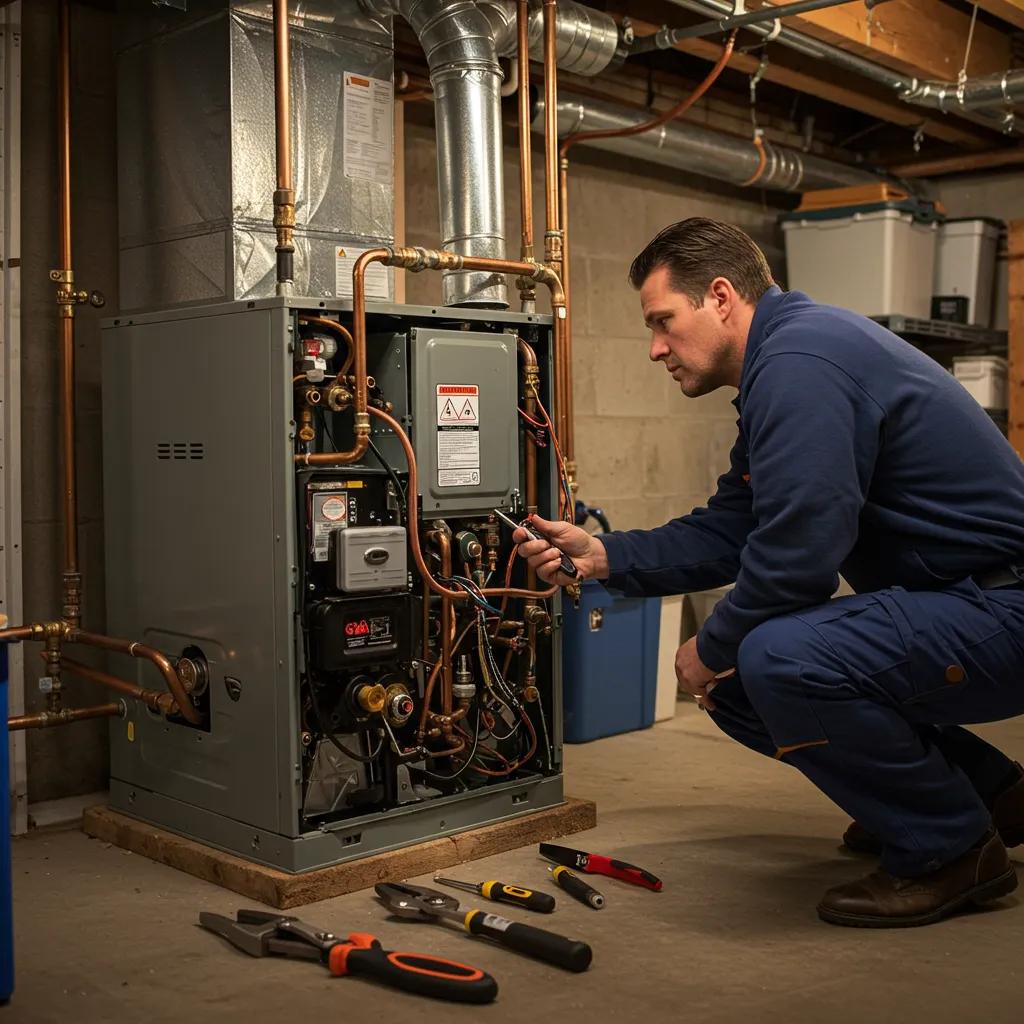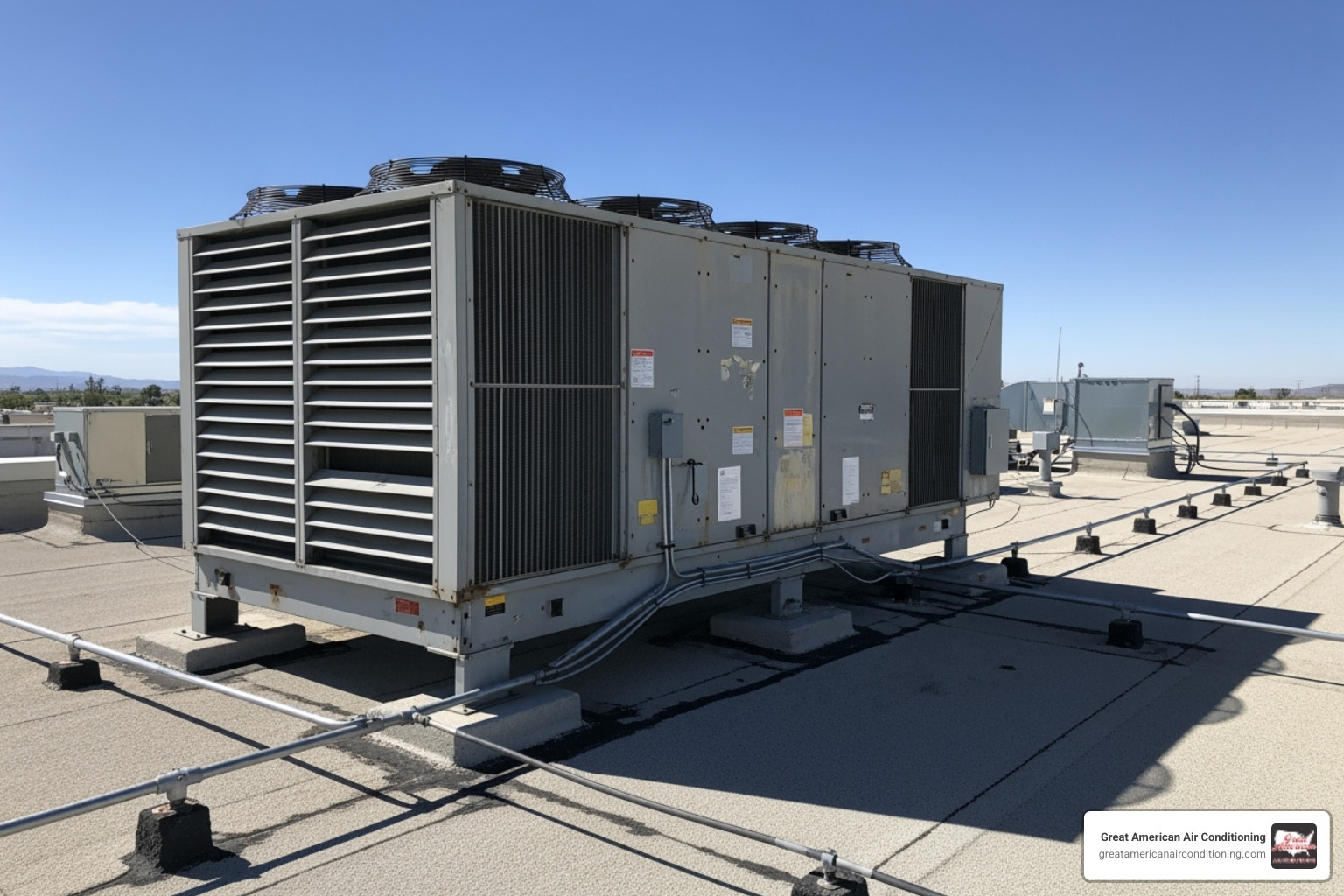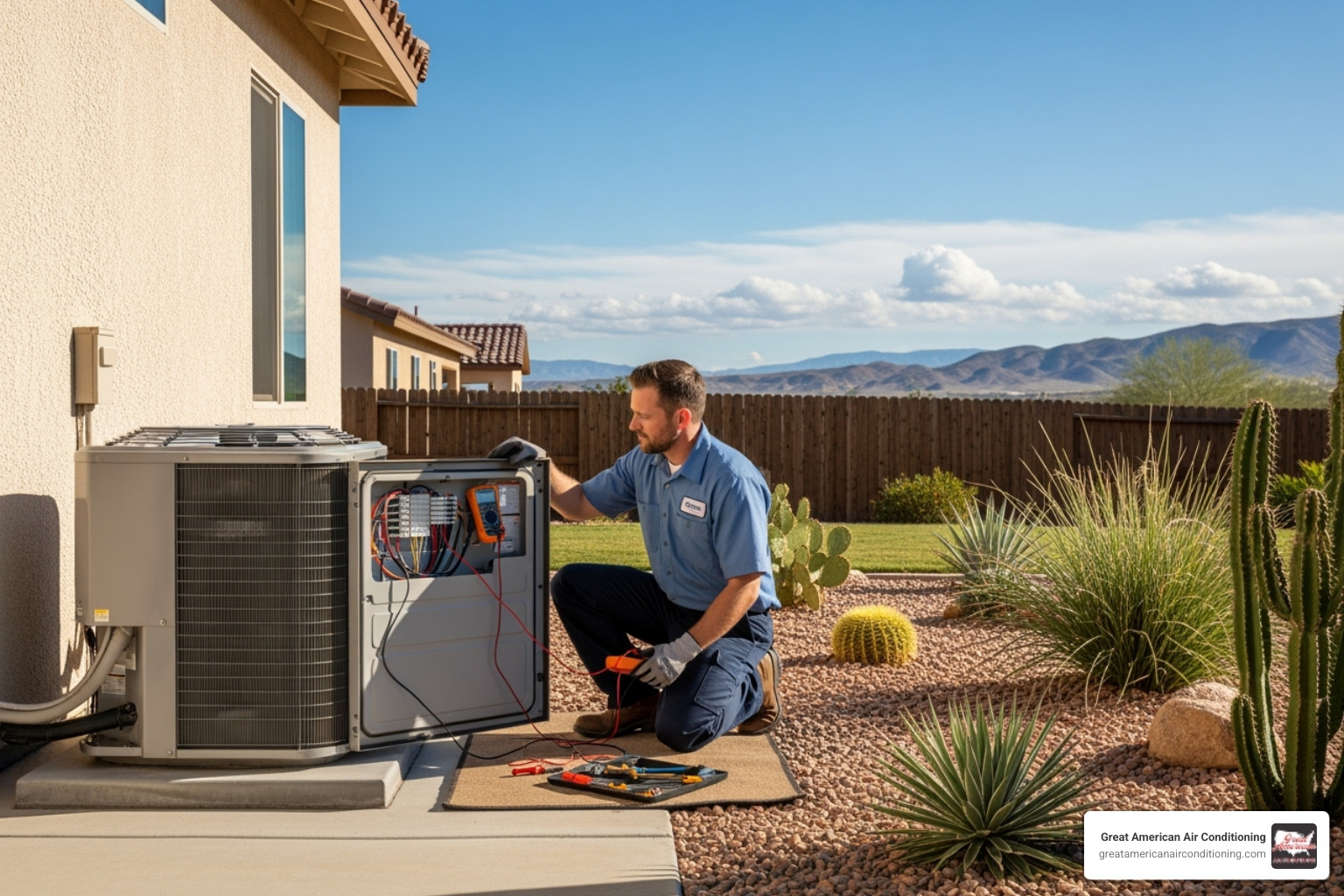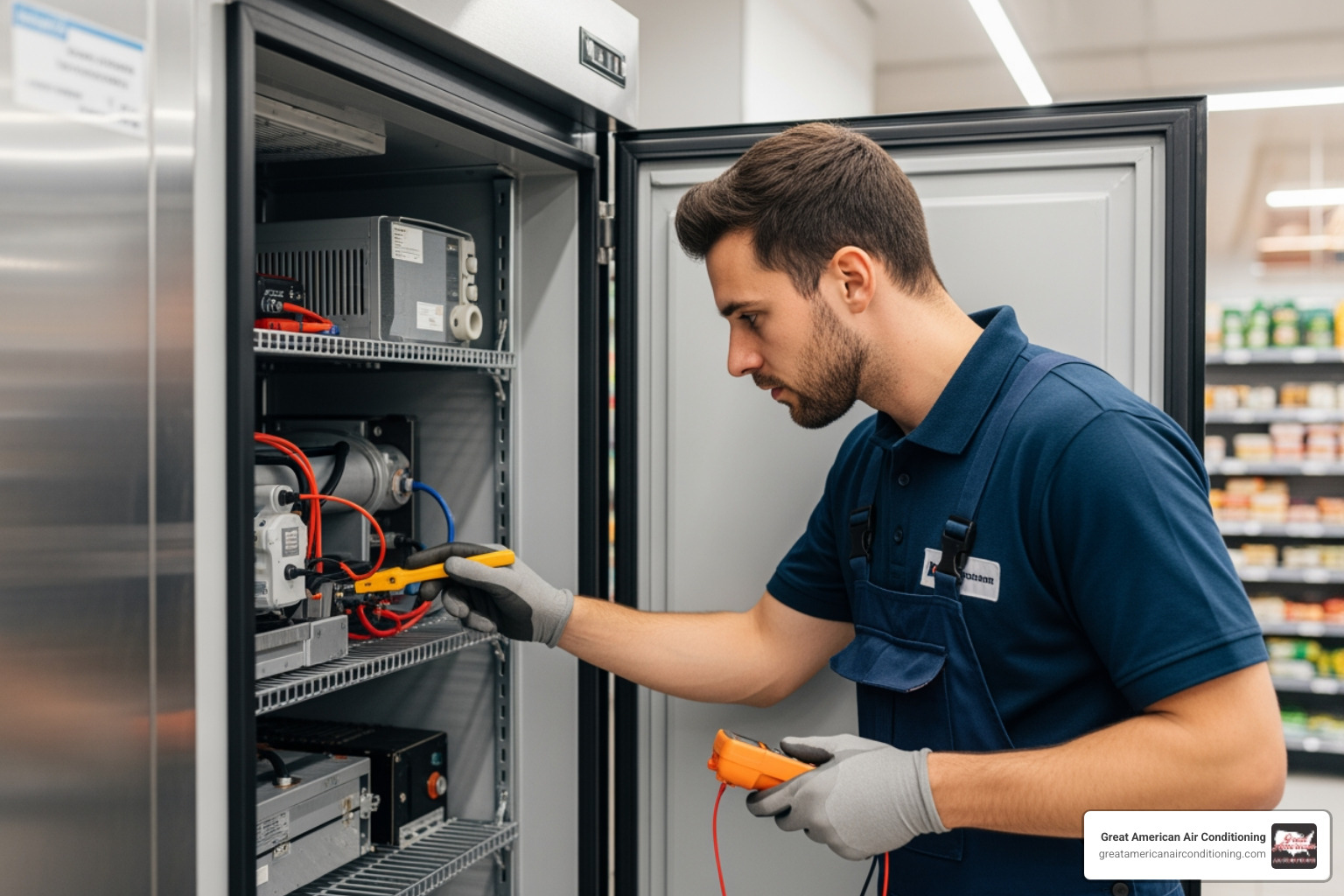Common HVAC Problems: Troubleshooting and Solutions for Phoenix Homeowners and Businesses
Air conditioning, furnaces, and whole-house HVAC systems can develop predictable issues that impact your comfort, energy bills, and indoor air quality. Knowing these common HVAC problems helps you diagnose issues quickly and decide when it's time to act. This guide covers practical troubleshooting for AC not cooling, furnaces that won’t heat, water leaks, noisy units, thermostat faults, dirty air filters, and electrical failures, with specific advice for Phoenix homeowners and businesses dealing with extreme summer heat and dust. You’ll find symptom checklists, safe DIY steps, decision-making guidance for calling professionals, and preventative maintenance actions to extend your system’s life. Each section includes clear diagnostic rules, concise how-to lists, and easy-to-understand comparison tables to aid quick decisions, plus advice on professional services for persistent or hazardous problems. Expect straightforward, localized tips for AC troubleshooting, furnace ignition issues, condensate drain clogs, noisy motors, thermostat replacement triggers, filter schedules for Phoenix dust, and electrical safety steps to protect your home or business. Let’s start by diagnosing AC performance in extreme heat, then move through heating, leaks, noise, thermostats, filters, electrical faults, and finally preventative maintenance so you can prioritize fixes and know when to contact a trained technician.
Why Is My AC Not Cooling? Troubleshooting Common Air Conditioning Issues
When your AC isn't cooling properly, it means the system’s heat-exchange or airflow processes are compromised, reducing its ability to transfer heat from indoors to outdoors. This leads to increased runtime and higher energy use. Issues like a low refrigerant charge, restricted airflow from dirty filters or coils, and mechanical failures such as compressor or fan problems all interfere with the refrigeration cycle and lower cooling output. Identifying the core issue—whether it’s airflow, refrigerant, or a mechanical/electrical failure—allows you to prioritize safe checks before escalating. Begin with simple visual and control checks, then move to component inspections and professional diagnostics when safety or refrigerant handling is involved; these steps prepare you for targeted repair or maintenance.
What Are the Symptoms of an AC Not Cooling Properly?

Common symptoms reveal where the system is failing: warm or inconsistent airflow suggests heat-exchange or refrigerant problems, while long run cycles or short-cycling indicate control or refrigerant imbalance. Visible ice or water signals evaporator coil or condensate issues. In Phoenix’s high ambient temperatures, an undersized unit might struggle during heat spikes, so noting when symptoms occur (during the hottest hours) helps isolate capacity problems. Watch for higher-than-normal utility bills and frequent thermostat adjustments, which often point to reduced efficiency rather than thermostat misconfiguration. Recognizing these symptoms early reduces the risk of compressor damage and helps you decide whether DIY steps or professional heating service are the next best move.
What Causes an AC to Blow Warm Air in Phoenix’s Extreme Heat?
High outdoor temperatures significantly increase the compressor's workload and reduce the cooling margin. Consequently, an AC that's already low on refrigerant or has dirty coils will start delivering warm air under extreme strain. Low refrigerant, often due to leaks, means the evaporator cannot absorb heat effectively. Similarly, blocked airflow from clogged filters or dirty evaporator/condenser coils prevents proper heat exchange. Electrical or compressor failures can also cause warm output; a failing compressor or capacitor might not sustain the required pressure. Understanding whether the problem stems from capacity, airflow, refrigerant, or a mechanical issue helps determine the safest next check and whether to shut the system down to prevent further damage.
How Can Homeowners Perform Basic AC Troubleshooting?
Homeowners can perform safe, low-risk checks to narrow down potential causes: verify the thermostat mode and setpoint, inspect and, if needed, replace HVAC filters, and check breakers and outdoor unit clearance for debris or vegetation restricting airflow. Resetting a tripped breaker or setting the thermostat fan to ON to test airflow are low-risk tests that can reveal simple fixes; always switch off power at the breaker before touching unit access panels. Record observed temperatures at vents and outdoors to provide accurate data to technicians if professional service is needed. After these steps, if cooling remains inadequate or if you observe refrigerant oil, ice on coils, or electrical burning smells, escalate to a licensed technician for refrigerant and compressor diagnostics.
- Thermostat and settings: Confirm the correct mode, temperature, and battery status.
- Air filter check: Replace or clean filters if visibly dirty to restore airflow.
- Outdoor unit inspection: Clear debris, ensure the fan spins freely, and check that breakers are on.
These basic checks often resolve simple airflow and control issues; if the problem persists, the next section explains when professional intervention is necessary.
The table above helps prioritize immediate actions and what information to record for technicians; its purpose is to speed up accurate diagnosis and reduce unnecessary service visits.
When Should You Call a Professional for AC Repair?
Call a professional when symptoms indicate refrigerant or electrical faults, when mechanical components show signs of failure, or when safety or legal restrictions apply to the task. This includes refrigerant leaks, electrical burning smells, compressor failure noises, or persistent lack of cooling after DIY steps. Professionals are equipped to handle refrigerant types and pressures, perform sealed-system diagnostics, and replace components like compressors, capacitors, and contactors safely and to code. For homeowners seeking service, Great American Air Conditioning, LLC offers AC repair service and AC maintenance plans tailored to Phoenix conditions and can perform diagnostic visits and repairs; contact details are available on the company’s official contact resources. Scheduling professional service is the right choice for sealed-system work, complex electrical issues, and recurring faults that suggest deeper mechanical wear.
How to Fix Furnace Not Heating: Common Problems and Repairs
A furnace that fails to heat means combustion or airflow processes are interrupted, or electric heating elements and control systems are defective, which reduces delivered heat and can create safety hazards. Common issues include ignition or pilot failures, blower motor or capacitor problems, clogged filters restricting airflow, and issues with gas supply or electrical control circuits. Identifying whether the fault is electrical, fuel-related, or mechanical helps determine safe homeowner actions and when to shut off systems. This section outlines signs, frequent causes, safe DIY checks, and clear thresholds for professional furnace repair.
What Are the Signs of a Furnace Not Heating Correctly?

Signs of a furnace not heating correctly include no ignition or intermittent heating cycles, uneven temperature distribution through rooms suggesting airflow or duct issues, and unusual odors or soot that could indicate combustion problems or a cracked heat exchanger. Mild Arizona winters often mask progressive declines in performance, so even modest reductions in output should be evaluated before colder spells arrive. Monitor thermostat behavior and listen for repeated start attempts or extended run times, which often forecast more severe mechanical issues. Early detection through these signs helps avoid emergency failures and supports safer, more cost-effective repairs rather than full replacements.
What Are the Most Frequent Causes of Furnace Failure?
Frequent causes include faulty ignition systems or ignitors that won’t spark, blower motor or capacitor failures that stop airflow, and dirty burners or clogged vents that impair combustion and efficiency. Mechanical wear on motors and bearings can produce grinding or humming noises and may precede complete motor failure, while a cracked heat exchanger is a critical safety hazard requiring immediate professional attention. Understanding which component class is affected—ignition, air-moving, combustion, or controls—allows for targeted troubleshooting and reduces unnecessary parts replacement. The next subsection explains safe homeowner checks before calling for professional diagnostics.
Can You Troubleshoot Furnace Problems Yourself?
Homeowners can safely check thermostat settings, power supply, and basic air filter and vent conditions; replacing filters, resetting tripped breakers, and confirming thermostat programming are appropriate DIY steps. Avoid working on gas lines, internal electrical connections, or combustion components due to safety and code concerns; such tasks require licensed technicians. If you detect the smell of gas, soot, or any suspected carbon monoxide indicators, evacuate the premises and seek emergency professional assistance rather than attempting repairs. These safety boundaries help protect occupants and property while gathering useful information for a technician’s diagnostic visit.
When Is Professional Furnace Repair Necessary?
Professional furnace repair is necessary when you detect gas odors or suspect leaks, experience repeated ignition failures, find cracked heat exchangers or any signs of combustion instability, or when blower motors or control boards fail. A trained technician will perform combustion analysis, inspect the heat exchanger, and replace worn motors, capacitors, or control modules safely and in compliance with regulations. For scheduling qualified heating work, Great American Air Conditioning, LLC provides furnace repair service and heating maintenance plans tailored to homes and businesses in Phoenix and surrounding areas; their specialists can advise on repair versus replacement decisions. Prioritize professional inspection whenever safety-related symptoms or persistent failures occur.
What Causes HVAC Systems to Leak Water and How Can You Fix It?
HVAC water leaks occur when condensate produced during cooling is not properly routed away from the air handler, often caused by clogged drains, frozen coils, pan damage, or improper installation. These leaks risk mold growth and structural damage if not addressed promptly. The condensate drainage path—from the evaporator coil, condensate pan, drain line, to its exit point outdoors or in a utility area—must be unobstructed and intact to prevent pooling. Quick homeowner actions can limit damage, while professional service corrects blocked or damaged components and evaluates associated refrigeration or airflow causes. This section details identification, common causes, DIY mitigation steps, and when to schedule professional leak repair.
How to Identify Symptoms of HVAC Water Leaks?
Early signs of HVAC water leaks include pooling or dripping water near the air handler, water stains on ceilings or walls below the unit, and musty odors indicating mold growth. A wet spot on insulation or trail marks along ductwork also signal leaks. Follow the water trail from visible drips back toward the air handler to determine the origin and check the condensate pan for overflow or corrosion. Regularly inspecting areas adjacent to the air handler and the ceiling below attic-mounted units helps catch leaks before they cause structural damage. Identifying these symptoms is the crucial first step before applying short-term mitigation or scheduling repair.
What Are the Common Causes of HVAC Leaks?
Common causes include clogged condensate drain lines from bacterial slime or debris, frozen evaporator coils due to restricted airflow, damaged or rusted condensate pans, and poor installation or improper unit pitch that prevents full drainage. Low refrigerant or airflow problems causing coil freezing will create meltwater when the system cycles off, which can overflow pans or leak through access panels. Corroded pans eventually develop pinhole leaks, especially in older systems or those with persistent moisture exposure. Determining whether the issue is drainage, airflow, refrigerant, or mechanical guides the appropriate repair scope and urgency.
The table clarifies which homeowner steps can mitigate damage and which signs require urgent professional evaluation to prevent mold and structural harm.
What DIY Steps Can Prevent or Fix HVAC Water Leaks?
Safe DIY actions include turning off the system before inspecting the condensate pan, clearing visible debris from accessible condensate lines with a wet/dry vacuum or approved cleaners, and replacing dirty filters to restore airflow and prevent coil freezing. Flush accessible drain lines with a cup of distilled vinegar followed by water monthly during heavy-use seasons to slow biological buildup; always follow manufacturer guidance. If you find rusted pans, cracked lines, or persistent clogging, switching the system off and calling a professional avoids repeated water damage. Consistent preventive care reduces emergency repairs and preserves indoor air quality.
When to Schedule Professional Leak Repair Services?
Schedule professional leak repair when leaks recur after DIY clearing, when you find mold or structural water damage, or when coils are repeatedly freezing, suggesting refrigerant or airflow problems that require sealed-system diagnosis. Technicians can perform safe condensate line clearing, replace corroded pans, inspect for hidden duct or ceiling damage, and test refrigerant pressures to correct root causes. For homeowners and businesses needing dependable support, Great American Air Conditioning, LLC offers professional leak repair and maintenance services across Phoenix and surrounding areas and can evaluate risks from repeated condensate faults. Prompt professional repair prevents escalating damage and restores safe operation.
How to Solve Noisy HVAC Units: Diagnosing and Fixing Strange Sounds
Noisy HVAC units usually indicate mechanical wear, loose components, or airflow obstructions; diagnosing the type of noise helps prioritize safe fixes versus technician repairs. Typical mechanisms include failing motor bearings producing grinding sounds, loose panels or duct components causing rattling, and electrical humming from capacitors or contactors. Homeowners can perform simple noise-reduction steps safely, but sudden loud bangs, grinding with smoke, or burning odors require immediate shutdown and professional attention. This section categorizes noises, explains causes, lists DIY fixes, and sets thresholds for contacting experts.
What Types of Noises Indicate HVAC Problems?
Different noises signal different faults: buzzing often implies electrical issues or loose wiring, grinding suggests motor or bearing failure, and rattling typically means loose panels, screws, or debris within the outdoor unit. Hissing may indicate refrigerant leaks in certain contexts, while popping sounds often come from duct expansion or contraction as temperatures change. Use precise sound descriptions and note the timing (startup, shutdown, continuous) to convey accurate information to technicians. Recognizing the noise type guides whether you can attempt a simple fix or must power down and call professionals.
What Causes Noisy Air Conditioners and Furnaces?
Aging motors and failing bearings produce grinding and humming as internal parts degrade. Loose mounting bolts, panels, or fan blades cause rattling, and obstructions in ductwork or outdoor units create intermittent noises. Blower wheel imbalance or accumulations of debris on the outdoor fan blades amplify vibration and reduce efficiency, while failing capacitors or contactors contribute to buzzing and intermittent operation. Proper diagnosis distinguishes worn mechanical parts from installation or duct issues and informs whether lubrication, tightening, or replacement is required. After identifying the cause, apply safe fixes or arrange technician repair as appropriate.
What Are Simple Noise-Reduction Fixes Homeowners Can Try?
Homeowners can tighten accessible screws and panels, clear leaves and debris from the outdoor unit, and replace clogged filters to reduce blower strain and associated noise; always turn power off at the breaker before accessing panels. Lubricate only those motors or bearings the manufacturer specifies as user-serviceable; many modern motors are sealed and should not be oiled. Inspect duct joints for loose connections and add simple foam or metal straps where vibrations travel into the building structure. These measures often silence common rattles and hums, and if noise persists, the next paragraph explains when to call a specialist.
When Should You Contact HVAC Experts for Noise Issues?
Contact HVAC experts when you hear grinding, burning smells, sudden loud bangs, metal-on-metal sounds, or when noises persist after tightening and cleaning, as these indicate imminent mechanical failure or electrical risk. Technicians can safely disassemble motors, replace bearings or capacitors, rebalance blower wheels, and inspect control boards to eliminate hazardous conditions. If you observe smoke, sparks, or a strong burning odor, shut down the system immediately and schedule an urgent inspection. Prompt expert intervention prevents catastrophic motor failure and reduces repair costs compared with ignored symptoms. For replacement options, consider HVAC replacement.
How to Diagnose and Repair Thermostat Problems in HVAC Systems
Thermostat faults disrupt control signals between users and HVAC equipment, causing short-cycling, failure to start, or incorrect temperatures; diagnosing thermostats involves both software and hardware checks. Common issues include dead batteries, misconfigured settings, wiring faults, or smart thermostat connectivity problems that prevent commands from reaching the system. Simple tests such as battery replacement, mode verification, and a manual reboot often resolve user-level issues, while wiring or control board-related problems require professional attention. This section guides diagnosis, explains impacts, and clarifies replacement criteria.
What Are Common Thermostat Malfunctions?
Common malfunctions include dead or weak batteries leading to lost settings, incorrect programming or schedules causing frequent cycling, and Wi-Fi or smart thermostat connectivity issues that prevent remote control or lead to unresponsiveness. Calibration drift or failed internal sensors can produce inaccurate temperature readings and cause the HVAC system to run incorrectly. Touchscreens and physical controls can fail over time through wear or power surges, resulting in intermittent control. Identifying whether the issue is power, software, or sensor-based guides appropriate troubleshooting steps.
How Do Thermostat Issues Affect HVAC Performance?
Thermostat faults can cause inaccurate temperature readings that lead to erratic on/off cycles, extended runtimes, and higher energy consumption, or they may prevent the system from starting at all, decreasing comfort. Short-cycling caused by misread temperatures stresses compressors and blowers, increasing wear and reducing system life. For energy-efficient HVAC solutions in Phoenix, accurate thermostat control is especially important to manage high cooling loads while avoiding unnecessary runtime. Correcting thermostat problems improves system reliability and fosters predictable energy usage.
What DIY Checks Can You Perform on Your Thermostat?
Perform safe DIY checks such as replacing batteries, verifying thermostat mode and temperature setpoint, rebooting or performing a factory reset per manufacturer instructions, and visually inspecting wiring for loose connections after switching power off. For smart thermostats, confirm Wi-Fi credentials and app connectivity and check for firmware updates that resolve known bugs. If wiring appears damaged or the device remains unresponsive after these steps, avoid further internal inspection and contact a qualified technician. These steps often restore basic function and prepare useful details for any professional call-out.
When Is Thermostat Replacement or Professional Repair Needed?
Professional replacement or repair is advised when thermostats remain unresponsive despite basic troubleshooting, when inaccurate readings persist after calibration attempts, or when smart thermostat functions fail beyond network issues. Technicians can verify low-voltage wiring, test compatibility with existing HVAC control systems, and install or configure advanced thermostats for zoning or efficiency optimization. Replacement also makes sense for outdated units lacking programmable or efficiency features that reduce energy use. A technician-guided upgrade improves control precision and can contribute to lower cooling costs in Phoenix’s climate.
How Can Preventative HVAC Maintenance Reduce Common Problems and Extend System Life?
Preventative HVAC maintenance reduces breakdowns and extends equipment life by catching small issues early, restoring designed airflow and heat-exchange efficiency, and ensuring electrical and mechanical components operate within specification. Routine tasks such as filter replacement, condensate drain cleaning, coil inspection, and electrical checks prevent many common failure modes and improve seasonal reliability. Professional maintenance plans combine scheduled inspections with documented service history, priority scheduling, and tailored adjustments for local climates such as Phoenix’s extreme summer heat and dust exposure. This section outlines essential tasks, energy and cost benefits, maintenance plan advantages, and how to schedule service.
What Are Essential Maintenance Tasks for Phoenix HVAC Systems?
Essential tasks include regular filter checks and timely replacement, outdoor unit clearance and coil cleaning to preserve heat transfer, condensate drain inspection and flushing to prevent leaks, and electrical component checks including capacitors and contactors. Seasonal pre-summer tune-ups that include refrigerant pressure checks, thermostat calibration, and blower inspection prepare systems for peak demand and reduce emergency failures. For homes with high dust loads or pets, increase filter frequency and inspect return-cabinet seals. These practical tasks reduce strain and align system performance with manufacturer design expectations.
How Does Regular Maintenance Improve Energy Efficiency and Lower Costs?
Regular maintenance restores airflow and heat-exchange efficiency, shortening cycle times and lowering electricity consumption while preventing degraded performance that drives up bills. Clean coils and properly charged refrigerant maintain rated capacity so systems reach setpoints faster and run less, which reduces wear and extends compressor and motor life. Early detection of failing components avoids catastrophic replacements and delivers better long-term ROI; recent industry analysis through 2024–2025 highlights maintenance as a key driver of lifecycle cost reduction. Systematic tune-ups therefore yield measurable savings and more reliable comfort.
What Are the Advantages of Professional HVAC Maintenance Plans?
Professional maintenance plans deliver comprehensive inspections by trained technicians, documented service records that support warranty claims, and priority scheduling for repairs that reduce downtime during peak seasons. Plans typically include filter changes, coil and drain cleaning, refrigerant checks, and electrical safety tests, which go beyond typical DIY checks and uncover issues before they escalate. For residents and businesses in Phoenix, professional plans are tailored to local heat and dust challenges, improving seasonal readiness and energy efficiency. Many customers choose plans to gain peace of mind and predictable maintenance cadence.
For homeowners ready to enroll in a maintenance plan, Great American Air Conditioning, LLC offers HVAC maintenance plans including scheduled inspections, tune-ups, and priority service designed for Phoenix conditions; contact options are available through the company’s public contact resources for scheduling. A professional plan ensures routine preventive measures are performed and documented, lowering the risk of emergency repairs and improving system longevity.
How to Schedule HVAC Maintenance with Great American Air Conditioning, LLC?
Scheduling maintenance begins by describing your system type and last service date to the provider so they can allocate the correct service scope and timing; technicians then perform a pre-season inspection and propose a maintenance schedule. Great American Air Conditioning, LLC serves homeowners and business owners in Phoenix and surrounding areas and provides maintenance visits that include filter checks, coil cleaning, condensate drain service, and basic electrical inspections. Ask for a documented checklist and priority scheduling when enrolling in a plan to ensure consistent service and clear expectations.
- List your system type and last service date: Provide this when booking to tailor the visit.
- Request a documented checklist: Ensure inspection items are written and retained.
- Ask about priority scheduling: Get faster response during peak season.
These scheduling steps make maintenance effective and predictable, completing the article’s practical guidance on preventing common HVAC problems.
Blogs post
Customer Testimonials
Our customers consistently share positive testimonials, praising our reliable service, expert technicians, and commitment to their comfort.
Ready to Transform Your Home?
Discover our exceptional home services tailored to meet your needs and enhance your living space.
.avif)







